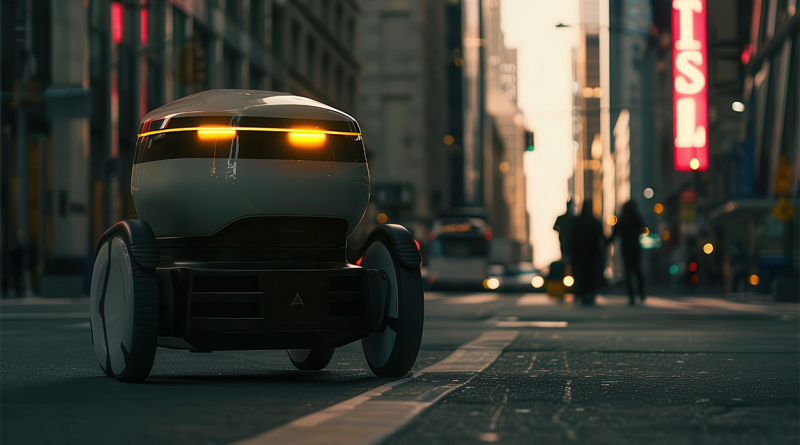The Rise of Autonomous Robots in South Korea
The landscape of last-mile delivery is undergoing a significant transformation with the rise of autonomous delivery robots. As the demand for contactless services continues to surge, companies are increasingly turning to these innovative solutions to meet consumer needs. South Korea, known for its technological prowess, is emerging as a key player in this field. The growing deployment of delivery robots by South Korean businesses highlights the country’s leading role in the advancement of autonomous solutions.
Autonomous delivery robots represent a fusion of cutting-edge AI and robotics technology, designed to navigate complex environments and deliver goods efficiently. These robots are becoming an integral part of the logistics ecosystem, offering a glimpse into the future of delivery services. The shift towards automation is driven by the need for increased efficiency, safety, and convenience, especially in the wake of the COVID-19 pandemic. As we explore the developments in this sector, it becomes clear that South Korea’s innovative approach is setting new benchmarks in the global market.
South Korean Industry Leaders Are Innovating with Advanced Delivery Robots
South Korean companies such as LG Electronics and Hyundai Motor Group are at the forefront of the autonomous delivery robot revolution. LG’s CLOi ServeBot and Hyundai’s DAL-e exemplify the advanced capabilities of modern delivery robots. The CLOi ServeBot, designed for indoor environments like restaurants and hospitals, navigates using sophisticated AI algorithms and multiple sensors. It efficiently delivers food, drinks, and medical supplies, enhancing service delivery and operational efficiency.
Hyundai’s DAL-e robot, on the other hand, is designed to interact with customers in retail settings. Equipped with facial recognition and voice command features, DAL-e provides personalized customer service, answering queries and guiding customers through stores. These innovations highlight the versatility and potential of autonomous robots in various sectors beyond just delivery.
The technological advancements driving these robots are impressive. AI and machine learning algorithms enable robots to learn from their environment, improving their navigation and interaction capabilities over time. Advanced sensors and cameras allow for precise mapping and obstacle detection, ensuring safe and efficient operation. These technologies collectively enhance the robots’ ability to operate autonomously, minimizing human intervention and maximizing efficiency.
The Global Market for Delivery Robots is Expanding Rapidly Despite Challenges
The global market for autonomous delivery robots is on a rapid growth trajectory, projected to reach $34 billion by 2027. This growth is fueled by several factors, including the increasing demand for contactless services, advancements in AI and robotics, and the need for efficient last-mile delivery solutions. The adoption of autonomous delivery robots is particularly pronounced in urban areas, where traffic congestion and high delivery volumes present significant challenges.
However, the expansion of this market is not without challenges. Regulatory hurdles are a major concern, as the deployment of autonomous robots involves navigating complex legal frameworks. Different countries have varying regulations regarding the use of robots in public spaces, which can hinder the widespread adoption of these technologies. In South Korea, regulatory bodies are working closely with companies to develop guidelines that ensure the safe and efficient operation of delivery robots.
Cybersecurity is another critical issue. Delivery robots handle sensitive data, including delivery addresses and customer information, making them potential targets for cyberattacks. Companies are investing heavily in cybersecurity measures to protect this data and ensure the privacy of their customers. Robust encryption, secure communication protocols, and regular software updates are some of the strategies being employed to mitigate cybersecurity risks.
Consumer Acceptance of Delivery Robots is Growing Steadily with Promising Future Prospects
Consumer acceptance of delivery robots is steadily increasing. A recent survey indicated that 60% of consumers are willing to use robot delivery services, a significant rise from previous years. The convenience and novelty of having goods delivered by robots appeal to a broad demographic, from tech-savvy young adults to elderly individuals seeking contactless delivery options.
The future of autonomous delivery robots looks promising, with ongoing advancements in AI and robotics expected to drive further adoption. Enhanced AI algorithms will improve robots’ decision-making capabilities, allowing them to navigate more complex environments and handle a wider range of tasks. Additionally, the integration of IoT (Internet of Things) technology will enable seamless communication between robots and other smart devices, further enhancing their efficiency.
South Korea is well-positioned to lead this growth. The country’s strong technological infrastructure, combined with its innovative companies and supportive regulatory environment, creates an ideal ecosystem for the development and deployment of autonomous robots. As South Korean companies continue to innovate and push the boundaries of what’s possible, they are setting new standards in the global market.
Real-World Applications Demonstrate the Benefits of Autonomous Delivery Robots
Several case studies highlight the successful deployment of autonomous delivery robots in South Korea. LG’s CLOi ServeBot has been extensively used in hospitals and restaurants, where it delivers meals and medical supplies with precision and reliability. These robots have proven to be particularly beneficial in reducing human contact and improving operational efficiency during the COVID-19 pandemic.
Hyundai’s DAL-e robot has been deployed in retail stores, where it enhances the customer experience by providing personalized assistance and information. The robot’s ability to recognize faces and respond to voice commands makes it a valuable asset in creating a seamless and interactive shopping experience.
Industry experts believe that the successful deployment of these robots in South Korea serves as a model for other countries looking to integrate autonomous solutions into their logistics and customer service operations. The insights gained from these deployments provide valuable lessons in overcoming challenges and maximizing the benefits of autonomous technology.
The rise of autonomous delivery robots marks a significant milestone in the evolution of last-mile delivery services. South Korea’s leadership in this field, driven by its innovative companies and advanced technological infrastructure, is shaping the future of logistics. As these robots become more integrated into our daily lives, they promise to bring greater efficiency, safety, and convenience to the way we receive goods and services.
Sources:
- The Korea Economic Daily
- AP Style Guide
